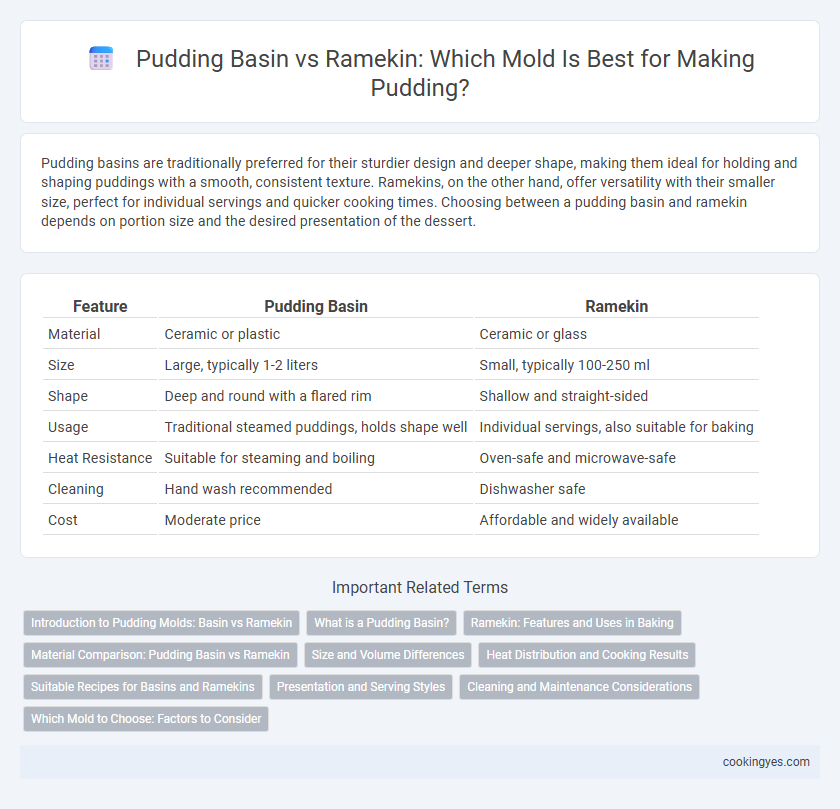Pudding basins are traditionally preferred for their sturdier design and deeper shape, making them ideal for holding and shaping puddings with a smooth, consistent texture. Ramekins, on the other hand, offer versatility with their smaller size, perfect for individual servings and quicker cooking times. Choosing between a pudding basin and ramekin depends on portion size and the desired presentation of the dessert.
Table of Comparison
| Feature | Pudding Basin | Ramekin |
|---|---|---|
| Material | Ceramic or plastic | Ceramic or glass |
| Size | Large, typically 1-2 liters | Small, typically 100-250 ml |
| Shape | Deep and round with a flared rim | Shallow and straight-sided |
| Usage | Traditional steamed puddings, holds shape well | Individual servings, also suitable for baking |
| Heat Resistance | Suitable for steaming and boiling | Oven-safe and microwave-safe |
| Cleaning | Hand wash recommended | Dishwasher safe |
| Cost | Moderate price | Affordable and widely available |
Introduction to Pudding Molds: Basin vs Ramekin
Pudding molds vary primarily between basins and ramekins, each offering distinct baking qualities and presentation styles. Basins, typically larger and deeper, allow for traditional steamed puddings with a moist, dense texture, while ramekins provide individual portions ideal for baked puddings with a smooth, custard-like consistency. Choosing between a pudding basin and a ramekin depends on the dessert's desired texture, serving size, and cooking method.
What is a Pudding Basin?
A pudding basin is a deep, lidded ceramic or heatproof bowl traditionally used in British cuisine for steaming puddings, designed to withstand prolonged boiling without losing shape or flavor. Unlike ramekins, which are shallow and typically used for individual portions of custards or souffles, pudding basins accommodate larger, denser desserts that require steam cooking. Their sturdy construction and tight-fitting lids ensure even cooking and moisture retention, making them ideal for classic steamed puddings like Christmas pudding or treacle pudding.
Ramekin: Features and Uses in Baking
Ramekins offer versatile baking options with their heat-resistant ceramic build, ensuring even heat distribution for perfectly cooked puddings and custards. Their individual serving size design allows for precise portion control and elegant presentation in both sweet and savory dishes. Commonly used for creme brulee, souffles, and baked puddings, ramekins withstand oven temperatures up to 500degF, making them ideal for baking delicate desserts with consistent results.
Material Comparison: Pudding Basin vs Ramekin
Pudding basins are traditionally made from glazed earthenware or ceramic, offering excellent heat retention and even cooking, while ramekins are often crafted from porcelain or tempered glass, providing durability and resistance to thermal shock. The thicker walls of pudding basins help maintain consistent moisture levels during steaming, essential for classic puddings, whereas ramekins' smooth surfaces aid in easy unmolding and are ideal for baked puddings or custards. Choosing between a pudding basin and ramekin depends on the cooking method and desired texture, with basins excelling in steam preparations and ramekins suited for baking or individual servings.
Size and Volume Differences
Pudding basins typically offer larger volumes, ranging from 500ml to over 1 liter, ideal for traditional steamed puddings that require ample space to expand during cooking. Ramekins, on the other hand, are smaller, usually between 100ml to 250ml, making them perfect for individual servings and precise portion control. The size and volume difference directly influence cooking time and presentation, with basins suited for family-sized dishes and ramekins enhancing personalized desserts.
Heat Distribution and Cooking Results
Pudding basins provide even heat distribution due to their thicker walls, resulting in uniform cooking and a tender texture. Ramekins, often made of porcelain or ceramic, heat up quickly but may create hotspots, potentially causing uneven cooking or overcooked edges. Choosing a pudding basin enhances moisture retention and prevents cracking, while ramekins offer individual portions but may require careful temperature control for consistent results.
Suitable Recipes for Basins and Ramekins
Pudding basins are ideal for traditional steamed puddings like Christmas pudding and treacle pudding, as their deep, curved shape supports rising and even cooking. Ramekins suit individual desserts such as creme brulee, souffles, and custards, providing precise portion control and faster baking times. Choosing between a basin and ramekin depends on recipe size, cooking method, and desired presentation.
Presentation and Serving Styles
Pudding basins offer a classic and traditional presentation ideal for steamed or baked puddings, providing a deep, rounded shape that showcases the dessert's texture beautifully when unmolded. Ramekins, with their individual serving size and crisp, elegant edges, are perfect for portion-controlled servings and enhance the visual appeal of custards, mousses, and creme brulee-style puddings. Choosing ramekins allows for versatile plating and personalized garnishing, while pudding basins emphasize a rustic, communal serving style.
Cleaning and Maintenance Considerations
Pudding basins made of ceramic or porcelain often require gentle hand washing to prevent chipping, while ramekins, typically made from tempered glass or stoneware, offer dishwasher-safe convenience for easier maintenance. The smooth surfaces of ramekins resist staining better than traditional pudding basins, reducing residue build-up and simplifying cleaning. Choosing ramekins can save time and effort in upkeep, especially when preparing multiple servings or frequent use is expected.
Which Mold to Choose: Factors to Consider
Choosing between a pudding basin and a ramekin depends on the type of pudding and desired texture; pudding basins are ideal for traditional steamed puddings due to their deep, rounded shape which allows even cooking, while ramekins suit smaller, individual portions like chocolate or bread puddings. Consider the material--ceramic or heatproof glass basins retain heat evenly, whereas metal ramekins may cook faster but risk uneven heating. Size and sealing ability also matter; pudding basins often come with lids to prevent water ingress during steaming, ensuring moisture retention and consistent results.
Pudding Basin vs Ramekin for mold choice Infographic

 cookingyes.com
cookingyes.com